|
The Italian Renaissance
|
|
I. Classical Humanism
A. The Medici and Florence
B. The Renaissance humanists: Petrarch, Pico, Alberti, Castiglione, female humanists, Machiavelli
II. Renaissance Artists
A. The early Renaissance
1. perspective
2. artist-scientists: Masaccio, Ghiberti, Da Vinci
3. The Renaissance portraits
B. The high Renaissance
1. painting
a. Leonardo, Raphael, Michelangelo
b. the Venetian school
2. sculpture
|
| I. Renaissance: Classical Humanism |
|
A. Renaissance (ca. 1400 to 1600)
B. Medieval Renaissances
C. Renaissance Humanism
|
| Renaissance |
|
Time: ca. 1400 to 1600
“Renaissance” = rebirth = revival of classicism
|
| Medieval Renaissances |
|
1. A myth: “death” of classical learning in the Middle Ages.
2. the late 8th and 9th centuries
Charlemagne—the Carolingian Renaissance
3. the 12th-century
a. Rediscovery of Greek learning through the Arab world, esp. Aristotle’s texts
b. Medieval universities in Bologna, Padua, Paris, and Oxford
(Black et al. 15-16)
|
|
Renaissance Humanism
|
|
1. Humanism: the study of the humanities
2. Etymology: “humanista”: slang for a student studying the liberal arts, i.e., grammar and rhetoric, which actually meant literature, poetry
and history, and the skill of communicating clearly and convincingly.
3. The medieval university curriculum on the other hand was overwhelmingly concerned with teaching logic.
(Black et al. 16-17)
4. Classical vs. Christian Traditions
a. “Very few scholars became so absorbed in pagan literature as to reject Christianity. . . . the majority of artists and scholars employed
the revived classical civilization in the service of the faith” (Black et al. 16).
b. Yet the humanities “tended to emphasize secular rather than transcendental values.” The humanista was thus “more concerned with
trying to understand human action and striving to improve himself as a person” (Black et al. 17).
5. Origin: Northern Italy
a. Roman ruins were a constant source of inspiration for artistic creations.
b. Italian wealth resulted in a large number of commissions for artists and architects.
c. Italian city-states closely resembled those of the classical world and shared the same civic values.
(Black et al. 21, 23)
6. Development in various Italian areas:
a. South: Kingdom of Naples
b. Middle: the Papal States
c. North:
(1) Venice: merchant oligarchy
(2) Milan: dynastic despotism
(3) Florence: a republic in name only, actually ruled by the Medici
|
|
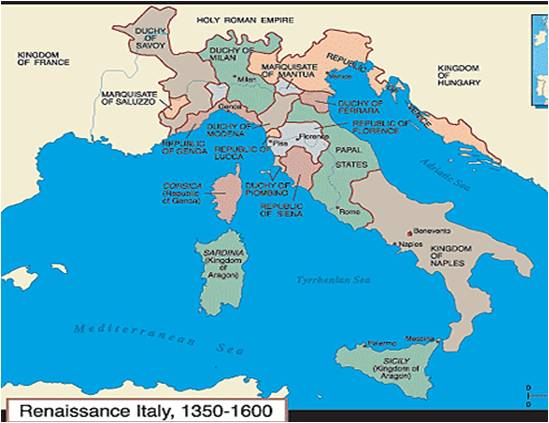
MAPS. Web. 13 Dec 2011.
http://www.maps.com/map.aspx?pid=11457
|
|
A. The Medici and Florence
|
|
Florence
|
|
“The de‘ Medici family . . . built a commercial empire; then they used cunning and at times cut-throat tactics to gain political power over several centuries (1380s - 1700s) . . . .”
The Medici coat of arms
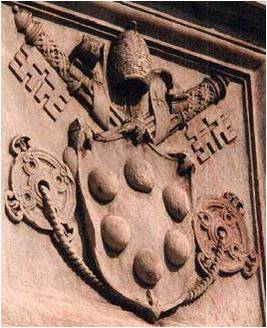
Candida Martinelli''s Italophile Site. Web. 12 Dec 2011.
http://italophiles.com/medici_1.htm
Europe''s First Euro: The Florin of Florence
|
Reverse of the Florin showing
the Florentine Giglio or Lilly.
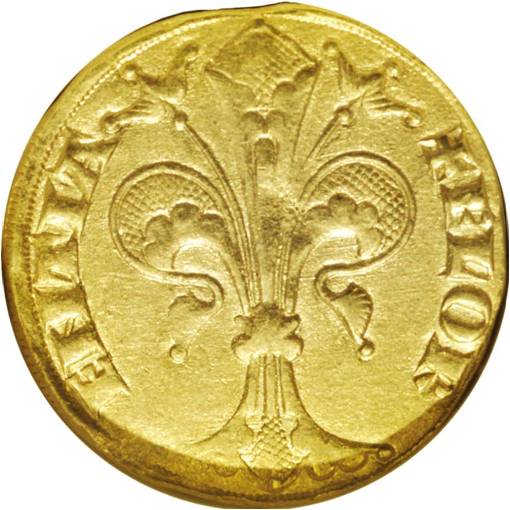
|
Front of the Gold Florin showing
Saint John the Baptist, patron saint of Florence
[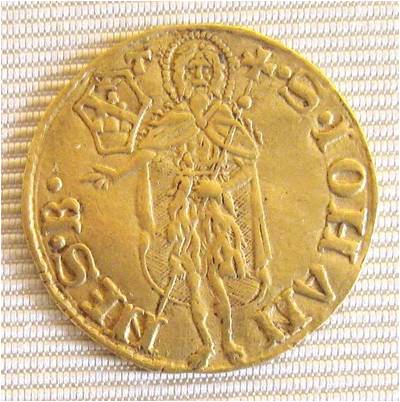
|
Counterlight’s Peculiars. Web. 13 Dec 2011.
http://counterlightsrantsandblather1.blogspot.com/2010/04/florence-rise-of-commune-part-1.html
|
|
The Medici Family
|
|
a. Giovanni de’ Medici (1360-1429): banker to the popes; the Medici became the richest family in Italy.
b. Cosimo the Elder (1389-1464): insisted that he was no more than a private citizen, though in control of the government; Florence
prospered under his rule.
c. Lorenzo the Magnificent (1449-92): patron for Botticelli and Michelangelo; son Giovanni became Pope Leo X in 1513)
d. Piero (1472-1503): ruled for two years; driven out of the city by the French and died in exile.
From: http://galileo.rice.edu/gal/medici.html
|
|
Benozzo Gozzoli: Procession of the Magi
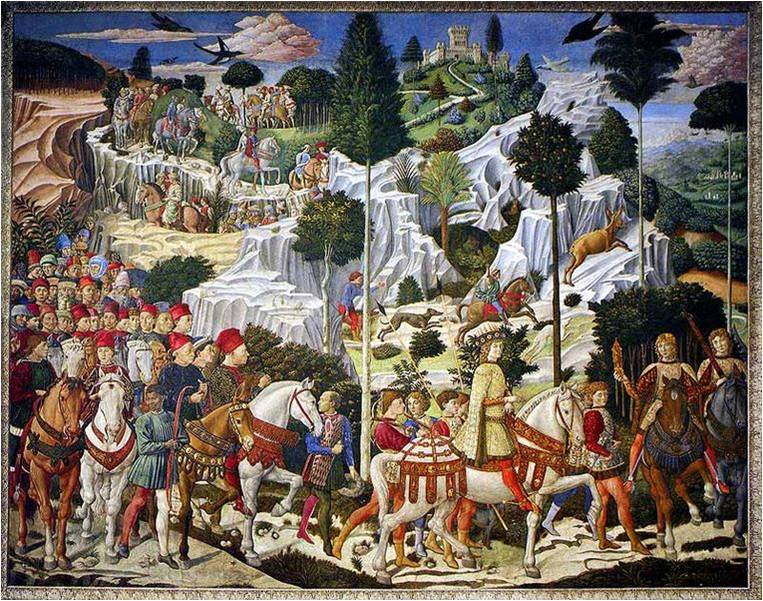
Wikipedia. Web. 13 Dec 2011.
http://en.wikipedia.org/wiki/File:Gozzoli_magi.jpg
Gozzoli: Procession of the Magi
|
|
B. Renaissance Humanists
|
|
A. Petrarch
B. Marsilio Ficino
C. Pico della Mirandola
D. Leon Battista Alberti
E. Baldassare Castiglione
F. Female Humanists:
1. Laura Cereta
2. Lucretia Marinella
G. Niccolò Machiavelli
|
|
Petrarch (1304-1374)
|
|
a. Father of humanism
b. “When it comes to thinking or speaking of religion, that is, of the highest truth . . . I certainly am not a Ciceronian or a Platonist but a
Christian” (qtd. in Perry, Peden and Von Laue, 282).
c. Famous as a forerunner of Christian humanists and for his sonnets.
Petrarch: poet laureate
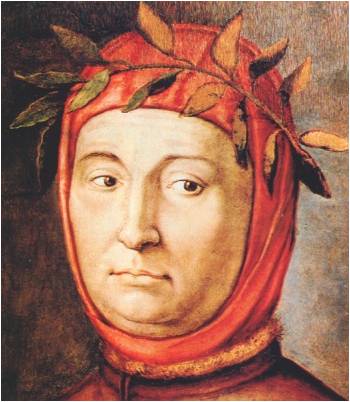
Biography Center. Web. 13 Dec 2011.
http://www.biography-center.com/biographies/18429-Petrarch_Francesco.html
d. Petrarchan Sonnet
(1) An octave (8 lines) followed by a sestet (6 lines), rhyming abab/abab/cde/cde.
(2) Subject matter: the hopes and pains of an adoring male lover
(3) Conceit: a figure of speech which establishes a striking parallel, usually ingeniously elaborate, between two very dissimilar things or
situations.
|
|
Marsilio Ficino (1433-99)
|
|
a. Founded the Platonic Academy in Forence supported by his patron Cosimo de’ Medici.
b. Translated all of Plato’s writings into Latin.
c. Neoplatonism:
(1)a reaction against Aristoteleanism
(2)Ficino’s doctrine of Platonic love: spiritual love attracts the soul to God while spiritual love is inspired by physical beauty. The human soul, hence, is the mediator between ideas and the physical world.
(Fiero 384)
|
|
Pico della Mirandola (1463-94)
|
|
a. Translated a lot of ancient literary works in Hebrew, Arabic, Latin, and Greek
b. The humanist manifesto: Oration on the Dignity of Man
e.g. (1) “We have given you, Oh Adam, no visage proper to yourself, nor nay endowment properly your own, in order that whatever place,
whatever form, whatever gifts you may, with premeditation, select, these same you may have and possess through your own judgment
and decision” (from Pico’s Oration; Fiero 386).
e.g. (2) “The nature of all other creatures is defined and restricted within laws which We have laid down; you, by contrast, impeded by no
such restrictions, may, by your own free will, to whose custody We have assigned you, trace for yourself the lineaments of your own
nature. . . .It will be in your own power to descend to the lower, brutish forms of life; [or] you will be able through your own decision, to
rise again to the superior orders whose life is divine” (from Pico’s Oration; Fiero 386).
|
|
Leon Battista Alberti (1404-1474)
|
|
a. On the Family: “Man can do anything he wants.”
b. Virtù: “power,” describes the self-confident vitality of the self-made Renaissance individual (Fiero 382)
|
|
Baldassare Castiglione (1478-1529)
|
|
a. L’uomo universale: the Renaissance man; the well-rounded person
b. The Book of the Courtier: preoccupied “with manners rather than with morals”; that is, “with how individuals act and how their actions
may impress their peers, rather than with the intrinsic moral value of those actions”
(Fiero 387).
|
|
Women Humanists
|
|
"Did Women Have a Renaissance?" http://www.columbia.edu/cu/sister/Renaissance.html
a. Laura Cereta (1468-99)
“. . . women have been able by nature to be exceptional, but have chosen lesser goals” (Fiero 391).
b. Lucretia Marinella (1571-1653)
“It can be stated therefore that when Aristotle or some other man reproved women, the reason for it was either anger, envy, or too much
self-love”
(Fiero 392).
|
|
Niccolò Machiavelli (1469-1527)
|
|
a. 1498 A prominent government official of the Florentine republic
b. Fascinated with the achievements of Cesare Borgia
c. Reflected the instability of Renaissance Italy
d. 1512 Deprived of his position
|
|
Machiavelli: The Prince
|
|
(1) A “handbook for tyrants”
(2) The end justifies the means: arguing that politics should be divorced from ethics.
(3) The pragmatic use of power for state management: only a ruthless prince could revitalize the spirit of independence.
(4) The book called for “the unification of Italy under a powerful and courageous leader” (Fiero 394).
(5) e.g. “. . . a Prince, and most of all a new Prince, cannot observe all those rules of conduct in respect whereof men are accounted good,
being often forced, in order to preserve his Princedom, to act in opposition to good faith, charity, humanity, and religion. He must
therefore keep his mind to shift as the winds and tides of Fortune turn, and . . . he ought not to quit good courses if he can help it, but
should know how to follow evil courses if he must . . .” (from Machiavelli, The Prince; Fiero 396).

|
|
II. Renaissance Artists
|
|
“The eye, which is called the window of the soul, is the chief means whereby the understanding may most fully and abundantly appreciate the infinite works of nature.” Leonardo da Vinci
(Fiero 398)
A. Early Renaissance (1400-1490): the Medici in Florence
B. High Renaissance (1490-1530): the Pope in Rome
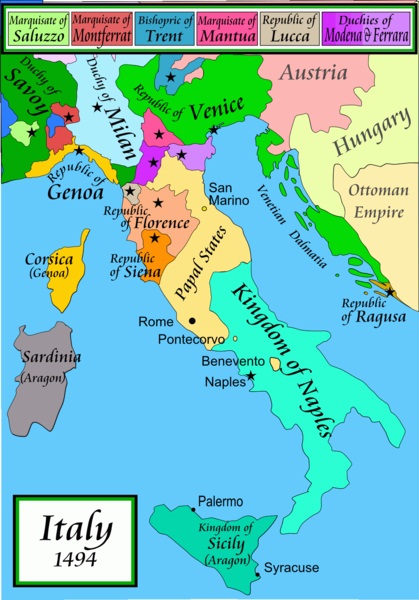
Wikipedia. Web. 26 Dec 2011.
http://en.wikipedia.org/wiki/File:Italy_1494_v2.png
|
|
A. The Early Renaissance
|
|
1. patronage
2. the artist as hero and genius
3. the revival of the classical nude
Donatello’s David
Botticelli’s Birth of Venus
(Fiero 399-400)
|
|
“Indeed, in this tribute to male beauty, Donatello rejected the medieval view of the human body as the wellspring of sin and anticipated the modern Western exaltation of the body as the seat of pleasure”
(Fiero 400).
|
Donatello, David, 1432
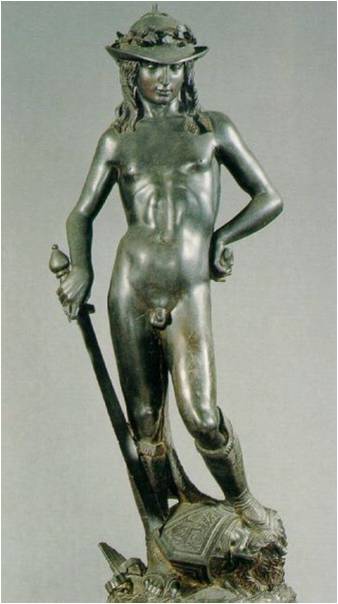
Temple College—The Florentine Renaissance:
1400-1492. Web. 13 Dec 2011.
http://tc.templejc.edu/dept/Art/ASmith/arts%201304/Joe1/ZoomSlide0017A.html
|
Polycleitos, Doryphoros (Spear Bearer), marble, 450
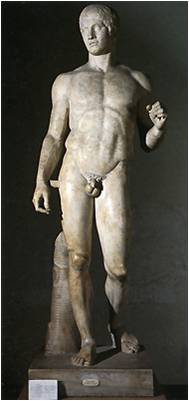
Theatre (NTU.edu.tw). Web. 13 Dec 2011.
http://vr.theatre.ntu.edu.tw/fineart/sculpture-wt/greek/doryphorus-x.jpg
|
Botticelli, Birth of Venus, 1482
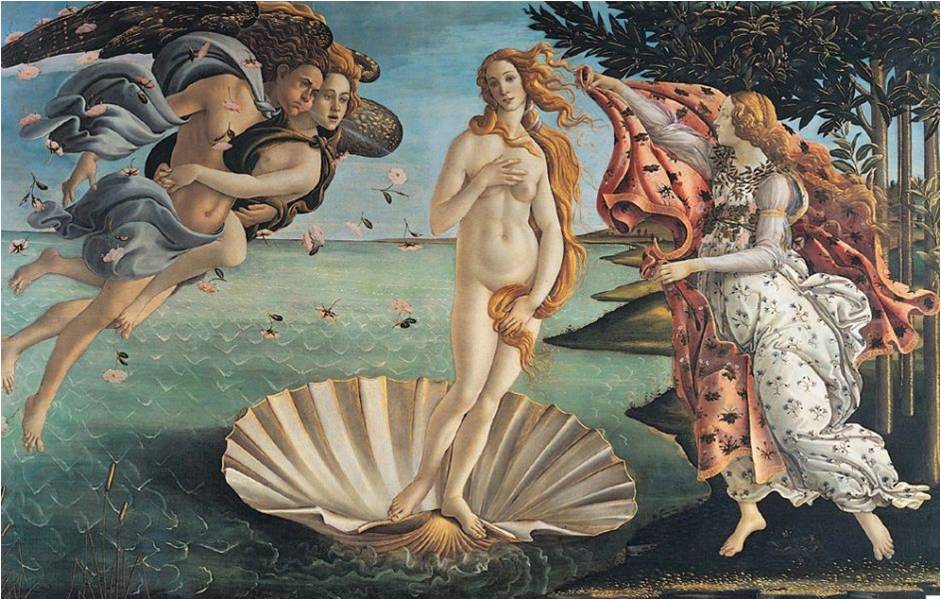
Temple College—The Florentine Renaissance: 1400-1492. Web. 13 Dec 2011.
http://tc.templejc.edu/dept/Art/ASmith/arts%201304/Joe1/ZoomSlide0028.html
Medici, Venus, first century
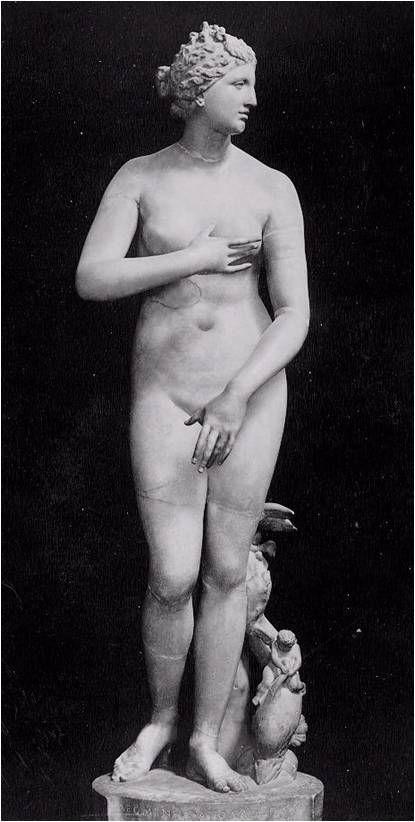
AERIA—Antikensammlung ERlangen Internet Archive. Web. 13 Dec 2011.
http://www.aeria.phil.uni-erlangen.de/photo_html/
plastik/weiblich/stehend/unbekleidet/aphrodite/medici1.jpg
|
|
Early Renaissance
Artist-Scientists
|
|
1. Perspective
a. Definition: a method of graphically depicting three-dimensional objects and spatial relationships in two-dimensional planes.
b. Filippo Brunelleschi developed the laws of perspective.
(http://maitaly.wordpress.com/2011/04/28/brunelleschi-and-the-re-discovery of-linear-perspective/)
c. Masaccio was among the first to use Brunelleschi''s rules to achieve the illusion of perspective in his paintings.
d. Leon Battista Alberti theorized the method in the book On Painting
   Masaccio, The Tribute of Money, ca. 1425. Masaccio, The Tribute of Money, ca. 1425.
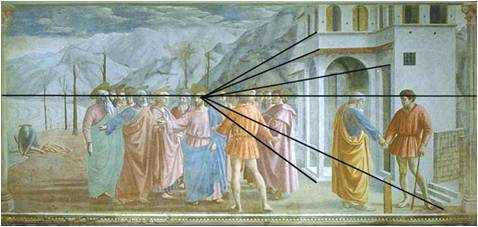
Web Gallery of Art. Web. 13 Dec 2011.
http://smarthistory.khanacademy.org/Masaccio
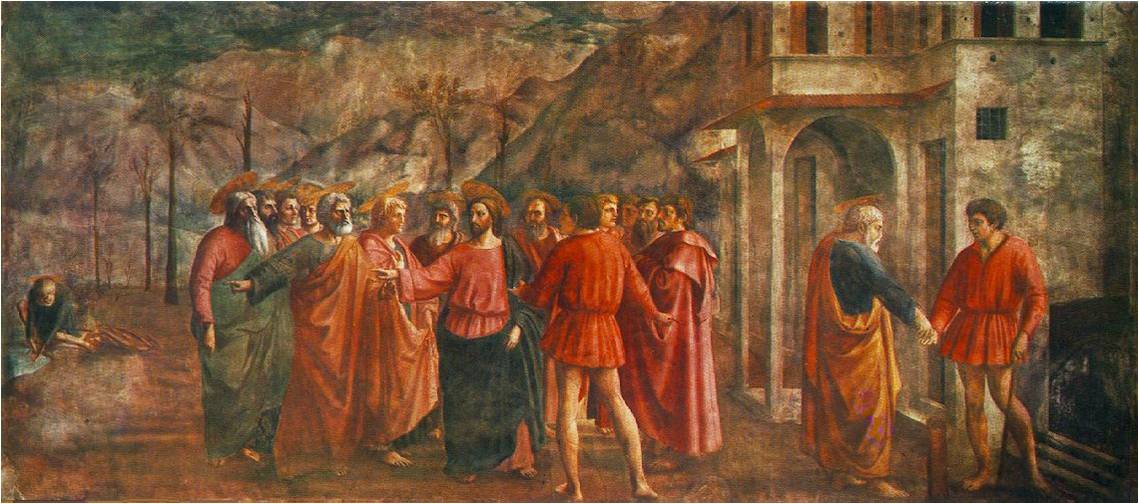
Smarthistory. Web. 13 Dec 2011.
http://www.wga.hu/art/m/masaccio/brancacc/tribute/tribute.jpg
|
|
|
the Baptistery 浸禮所
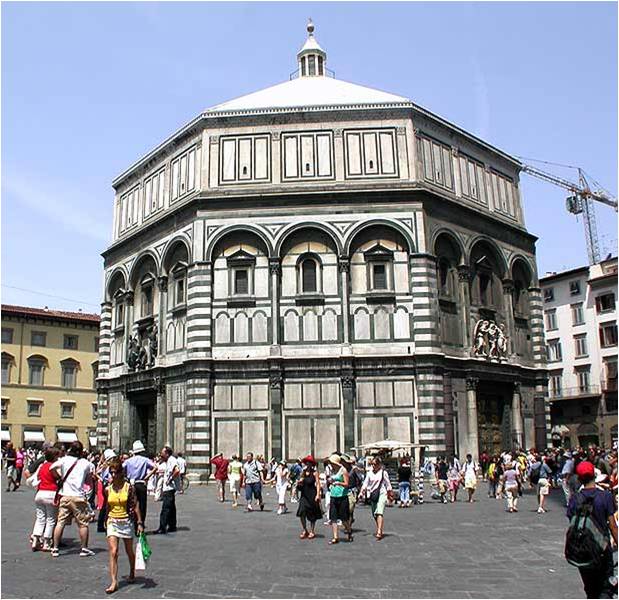
Sacred Destinations. Web. 26 Dec 2011.
http://www.sacred-destinations.com/italy/florence-baptistery
|
   an octagon an octagon
Lorenzo Ghiberti
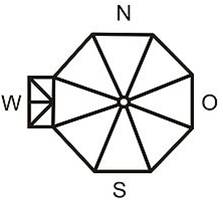
Andrea Pisano
Lorenzo Ghiberti ,
"the Gates of Paradise"
|
|
|
2. Early Renaissance Artist-Scientists:
a. Foci: scientific naturalism, empirical study, direct observation, art as a method to attain truth in nature
b. Artist-Scientists
Masaccio (1401-28)
Lorenzo Ghiberti (1378-1455)
Leonardo da Vinci (1452-1519)
|
|
3. The Renaissance Portrait
|
|
a. Portraiture and self-portraiture were revived. They were hallmarks of a new self-consciousness.
b. Two reasons:
(1) The desire to immortalize oneself by way of one’s physical appearance
(2) The wish to publicize one’s greatness in the traditional manner of Greek and Roman antiquity. (Fiero 406)
Roman antiquity.
|
|
Jan van Eyck,
Man in a Turban 1433
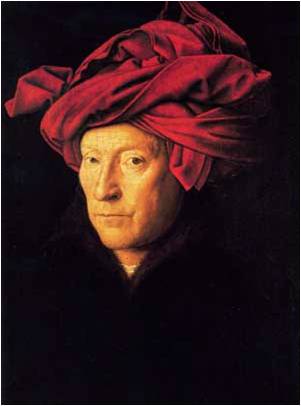
Italian Renaissance Art. Web. 13 Dec 2011.
http://www.italian-renaissance-art.com/Jan-Van-Eyck.html
Jan van Eyck, The Virgin of Chancellor Rolin, 1435
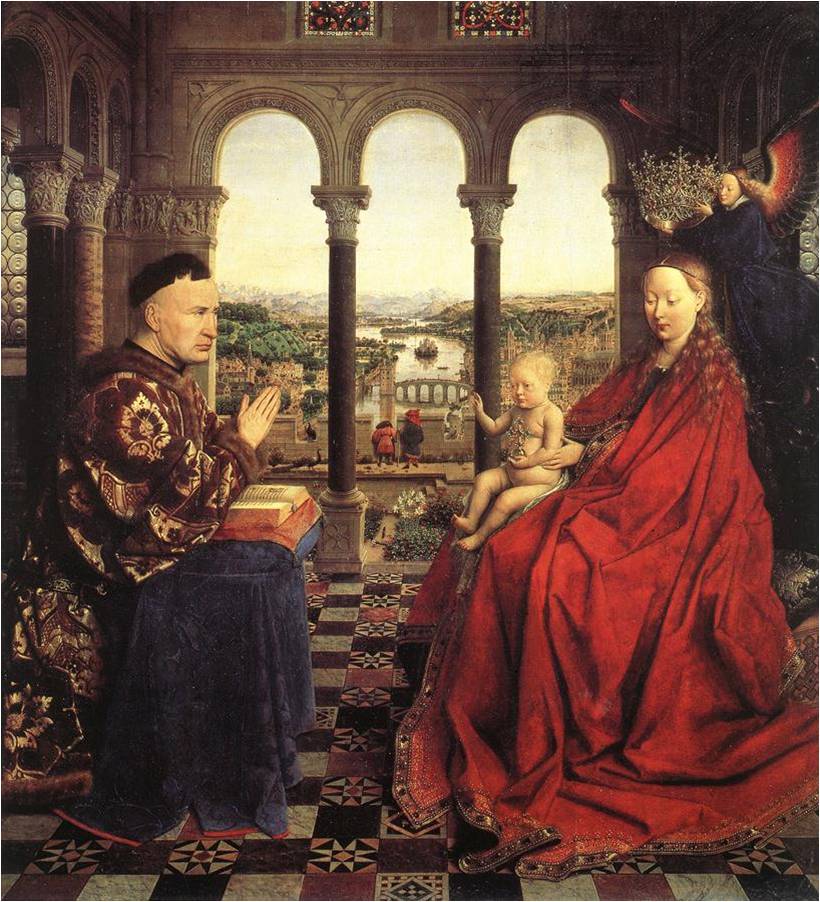
Wikipedia. Web. 26 Dec 2011.
http://gallery.euroweb.hu/html/e/eyck_van/jan/02page/index.html
|
|
|
|
B. The High Renaissance
|
|
A. Painting
1. Leonardo
2. Michelangelo
3. Raphael
4. the Venetian school: Giovanni Bellini; Giorgione; Titian
B. Sculpture
|
|
Leonardo da Vinci (1452-1519)
|
|
the archetype of “l’uomo universale” (the universal man)
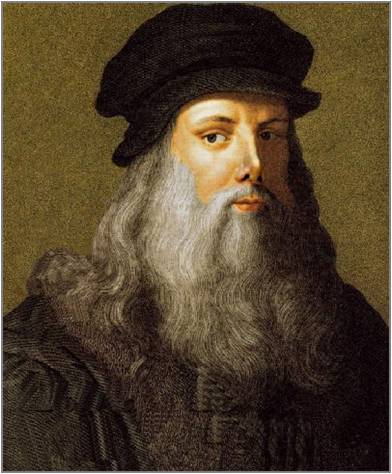
Kings Galleries. Web. 13 Dec 2011.
http://www.kingsgalleries.com/leonardo-da-vinci/
Works:
The Virgin of the Rocks,1483-86
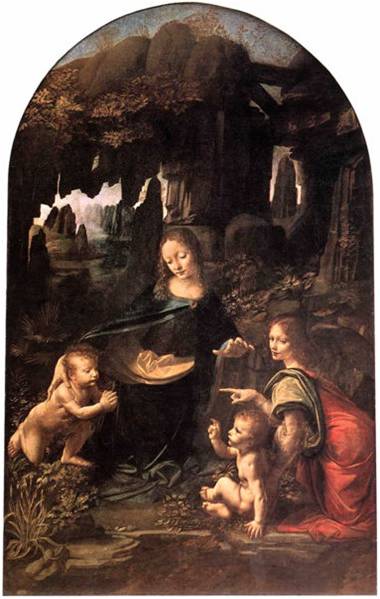
Wikipedia. Web. 13 Dec 2011.
http://en.wikipedia.org/wiki/File:Virgin_of_the_Rocks.jpg
The Last Supper, ca.1495
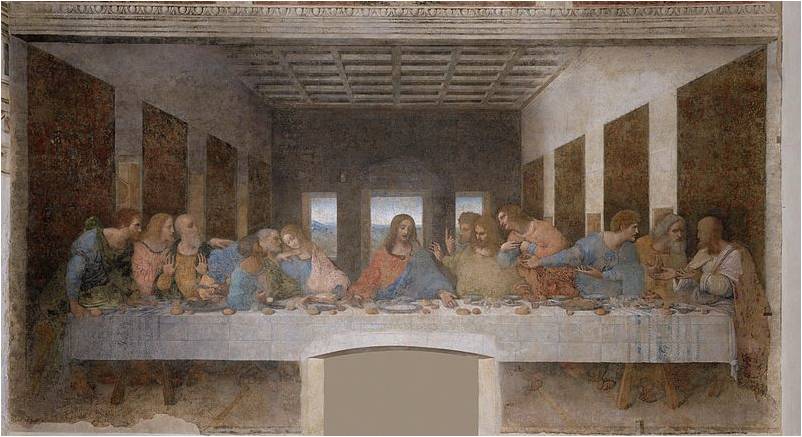
Wikipedia. Web. 13 Dec 2011.
http://en.wikipedia.org/wiki/File:DaVinci_LastSupper_high_res_2_nowatmrk.jpg
460x880 cm (15x29 feet) fresco on the wall of the dining hall of the Santa Maria delle Grazie convent in Milan, 1498
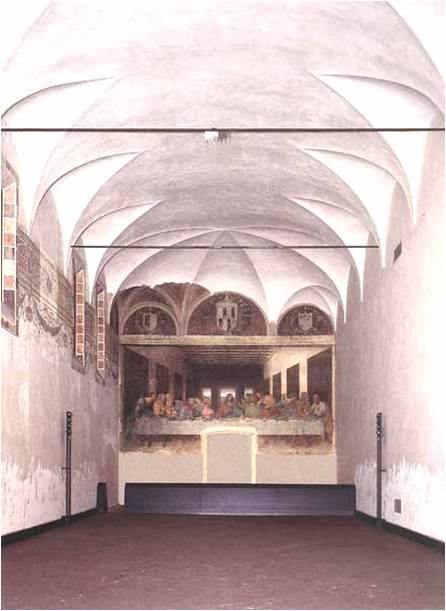
DeeperStudy Blog. Web. 13 Dec 2011.
http://deeperstudy.blogspot.com/2005/12/da-vincis-last-supper-already-coded.html
Santa Maria delle Grazie, Milan
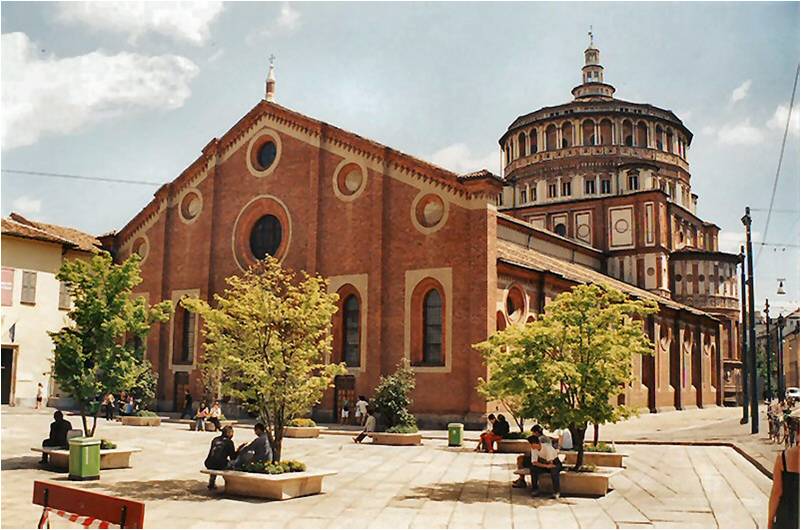
Wikimedia Commons. Web. 13 Dec 2011.
http://upload.wikimedia.org/wikipedia/commons/8/8d/Santa_Maria_delle_Grazie_Milano.jpg
The Mona Lisa, (or La Gioconda), 1503-6
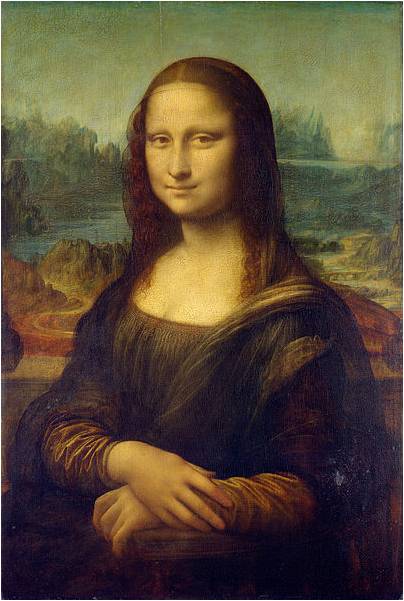
Wikipedia. Web. 13 Dec 2011.
http://en.wikipedia.org/wiki/File:Mona_Lisa,_by_Leonardo_da_Vinci,_from_C2RMF_retouched.jpg
|
|
Michelangelo Buonarroti (1475-1564)
|
|
Regarded himself first and foremost as a sculptor
|
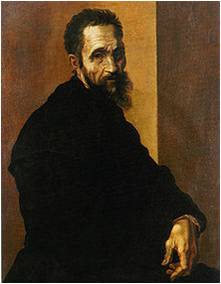
Mrs. Zerbs'' 6th Grade RenWeb. Web. 13 Dec 2011.
http://zerbsrenweb.wikispaces.com/2nd+Period+-+Michelangelo
|
|
Works:
Michelangelo, Sistine Chapel ceiling, 1508-12
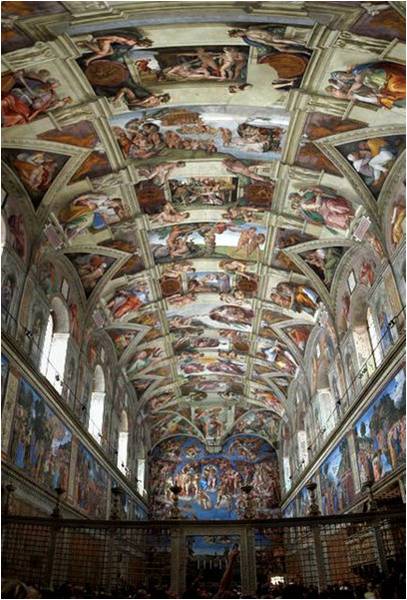
Wikipedia. Web. 13 Dec 2011.
http://en.wikipedia.org/wiki/File:Sistine_chapel.jpg
|
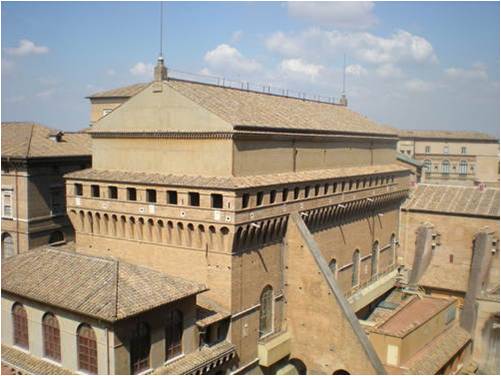
UThink: Blogs at the University of Minnesota. Web. 13 Dec 2011.
http://blog.lib.umn.edu/schue141/matt_machete/2009/05/roma_days_1011.html
|
Michelangelo, Sistine Chapel ceiling, 1508-12
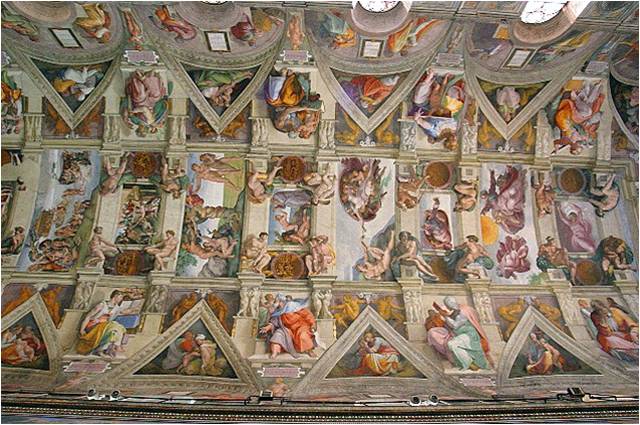
Wikipedia. Web. 13 Dec 2011.
http://en.wikipedia.org/wiki/File:Sistine_Chapel_ceiling_photo_2.jpg
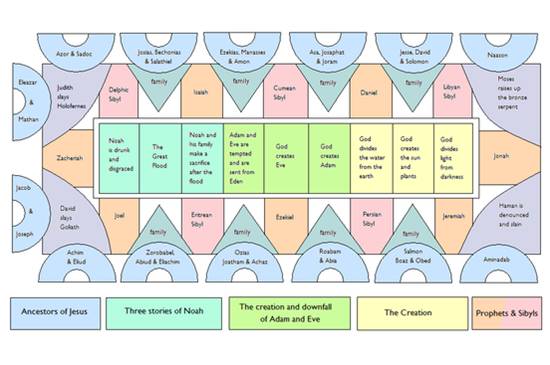
Wikipedia. Web. 13 Dec 2011.
http://en.wikipedia.org/wiki/Sistine_Chapel_ceiling
Creation of Adam
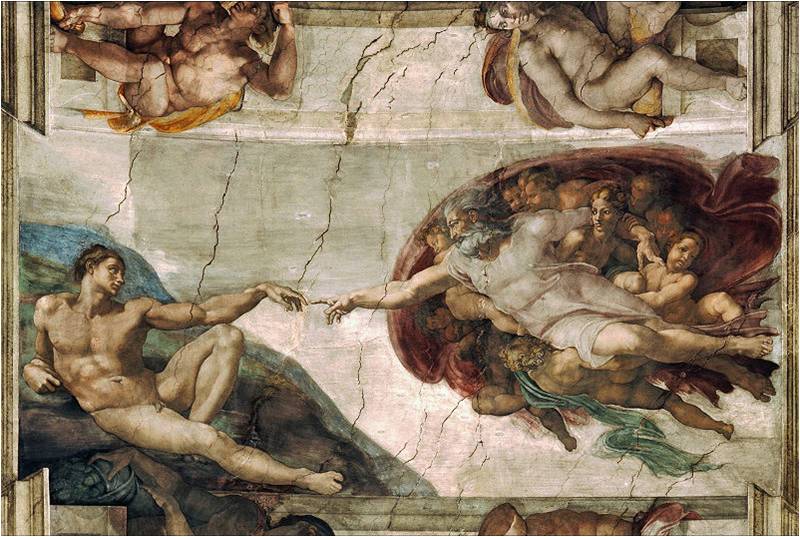
(1) God and Adam are “equal in size and muscular grace.”
(2) Symbolizes “the Renaissance belief in the potential divinity of humankind.”
(Fiero 426)
Wikipedia. Web. 13 Dec 2011.
http://en.wikipedia.org/wiki/File:Creation_of_Adam_Michelangelo.jpg
Michelangelo. The Fall of Man and the Expulsion from the Garden of Eden. 1508-1512
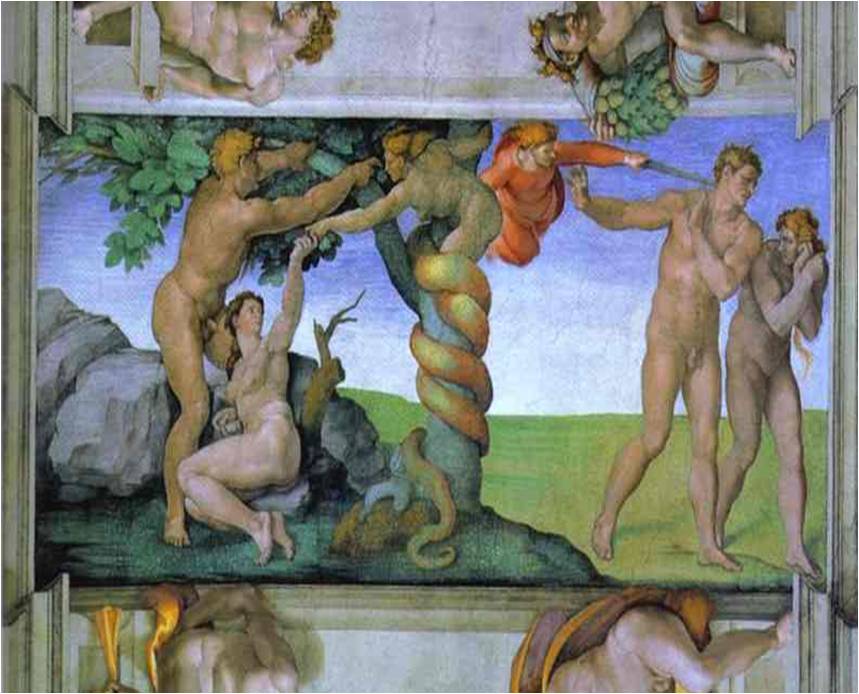
Olga’s Gallery. Web. 13 Dec 2011.
http://www.abcgallery.com/M/michelangelo/michelangelo34.html
|
|
Raphael Sanzio (1483-1520)
|
|
His compositions are “notable for their clarity, harmony, and unity of design” (Fiero 418).
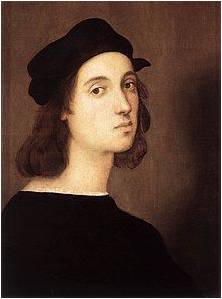
Wikipedia. Web. 13 Dec 2011.
http://en.wikipedia.org/wiki/File:Sanzio_00.jpg
Works:
Raphael, Madonna of the Meadow, 1508
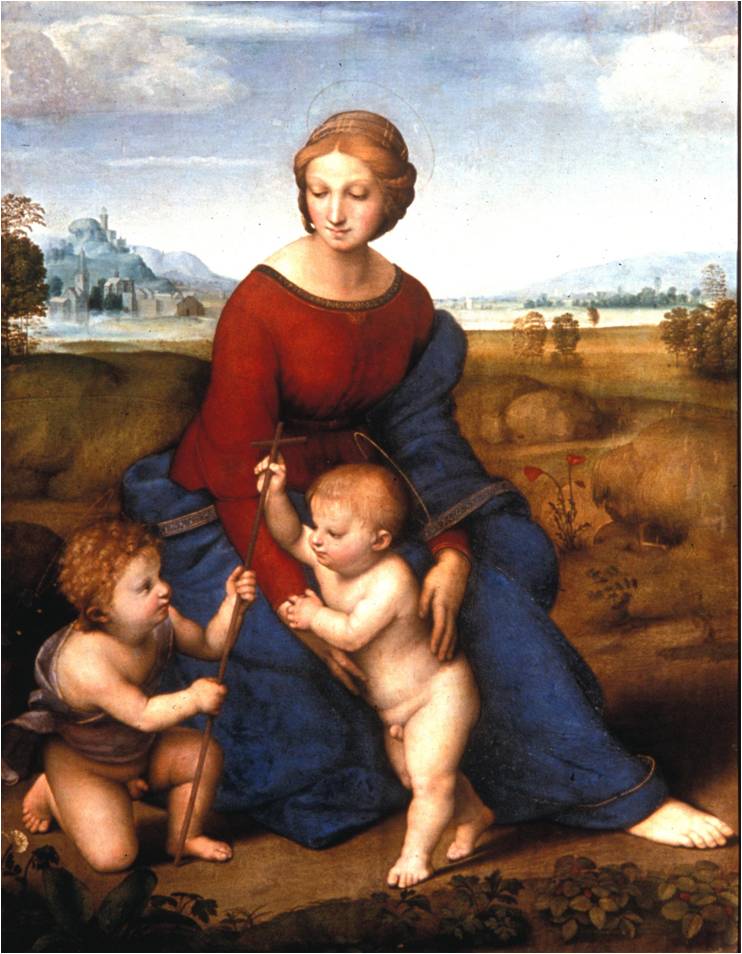
City College of San Francisco (CCSF).Web. 13 Dec 2011.
http://frontpage.ccsf.edu/artarchive/images/Raphael%20-%20Madonna%20in%20the%20Meadow,%20c.%201505.jpg
Raphael, The Alba Madonna, 1511
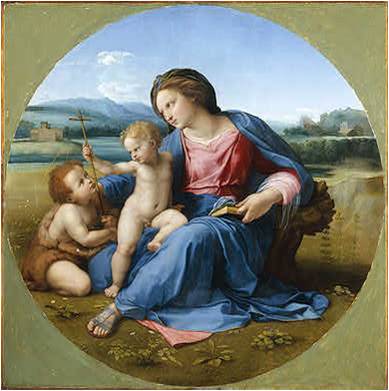
Smarthistory. Web. 13 Dec 2011.
http://smarthistory.khanacademy.org/raphael
Raphael, The School of Athens, 1509-11
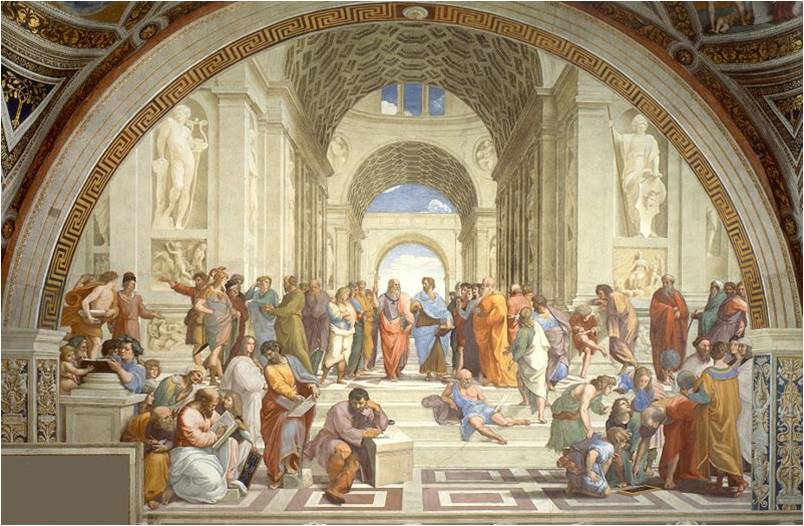
Wikipedia. Web. 13 Dec 2011.
http://en.wikipedia.org/wiki/File:Raphael_School_of_Athens.jpg
“The School of Athens advanced a set of formal principles that came to epitomize the Grand Manner: spatial clarity, decorum . . . balance,
unity of design, and grace . . . . These principles remained touchstones for Western academic art until the late nineteenth century”
(Fiero 419).
|
|
The Venetian School
|
|
(1) Features: reflected the luxurious life of Venice; appealed to the senses, not the mind; “delighted in the affective power of color”
(Fiero 428).
(2) Painters:
Giovanni Bellini (c. 1430-1516)
Giorgione (c. 1478-1510)
Titian (c. 1490-1576)
1.reflected the luxurious life of Venice.
2.appealed to the senses, not the mind.
3.“delighted in the affective power of color” (Fiero 428).
|
|
Bellini, Procession of the Relic of the True Cross before the Church of Saint Mark, 1496, oil on canvas
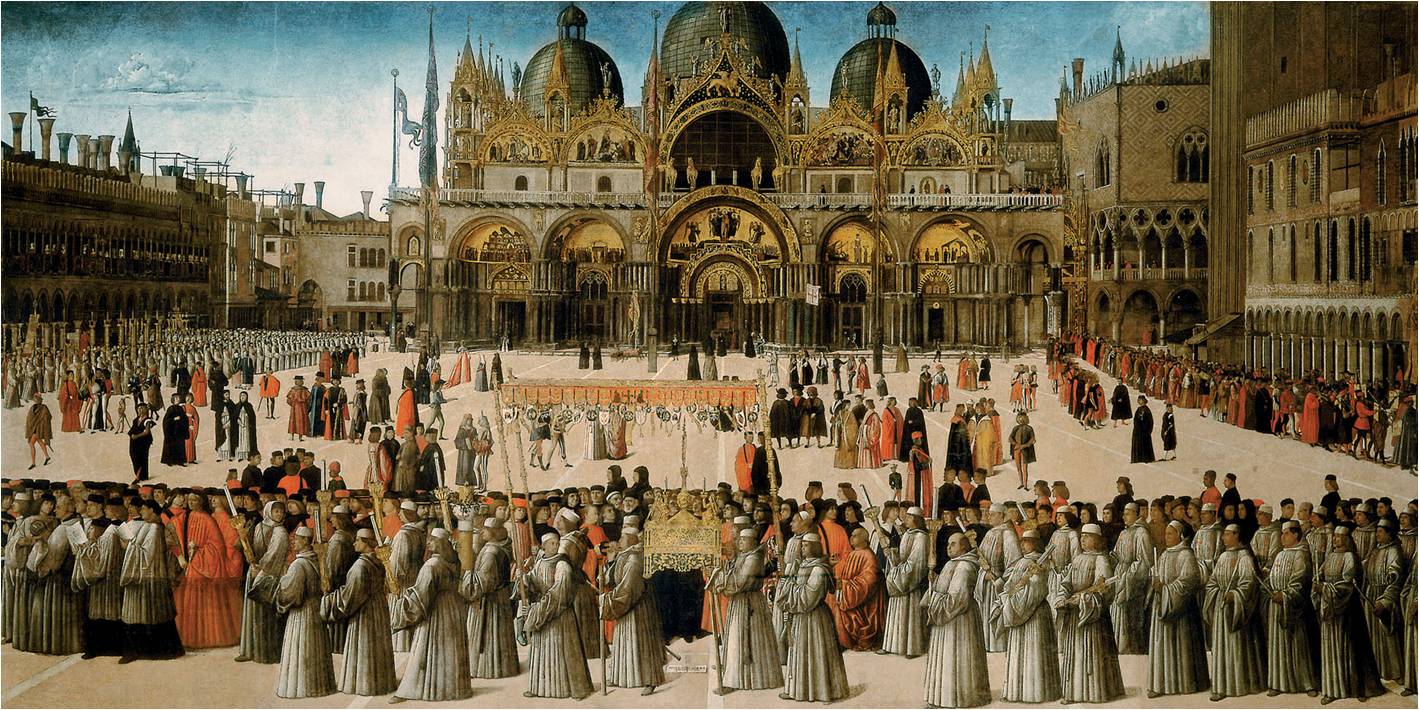
Earlham College. Web. 13 Dec 2011.
http://legacy.earlham.edu/~vanbma/20th%20century/images/surveydayfifteen.htm
Giorgione, Pastoral Concert, ca. 1505
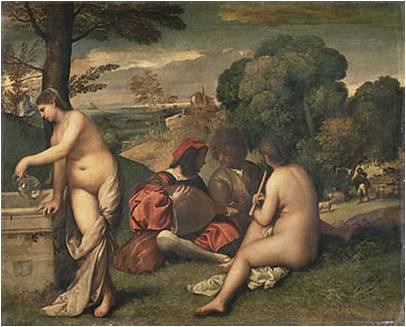
National Gallery of Art. Web. 13 Dec 2011.
http://www.nga.gov/press/exh/191/index.htm
Titian, Venus of Urbino, 1538-39
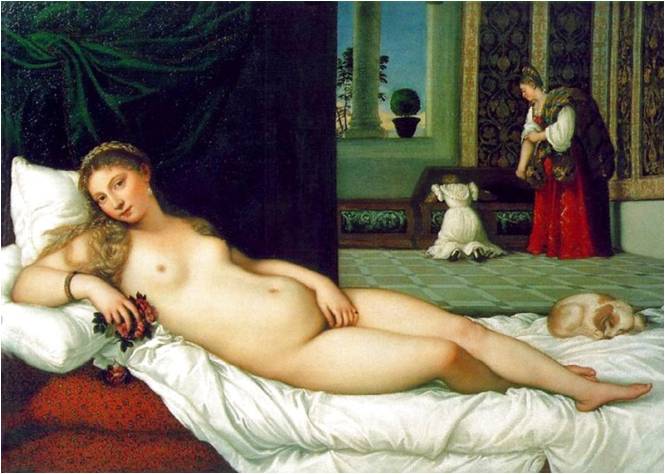
Wikimedia Commons. Web. 13 Dec 2011.
http://commons.wikimedia.org/wiki/File:Titian_Venus_of_Urbino.jpg
Allusions to marital life and fidelity:
(1) Roses in her hand
(2) The myrtle plant on the window sill: a symbol of Venus
(3) The dog: faithfulness
(4) The wedding chest
|
|
Sculpture
|
|
For Michelangelo, sculpture meant “taking away.” That is, it is “carving rather than modeling, as if releasing the image from within the
stone. All through his career the unfinished creatures recur, struggling for freedom as if imprisoned in the stone—like man, according to
Neo-platonic doctrine, imprisoned in his body” (Piper 133).
Michelangelo’s Masterpieces:
Michelangelo, Unfinished Bound Slave (1519-36) Marble, height 208 cm
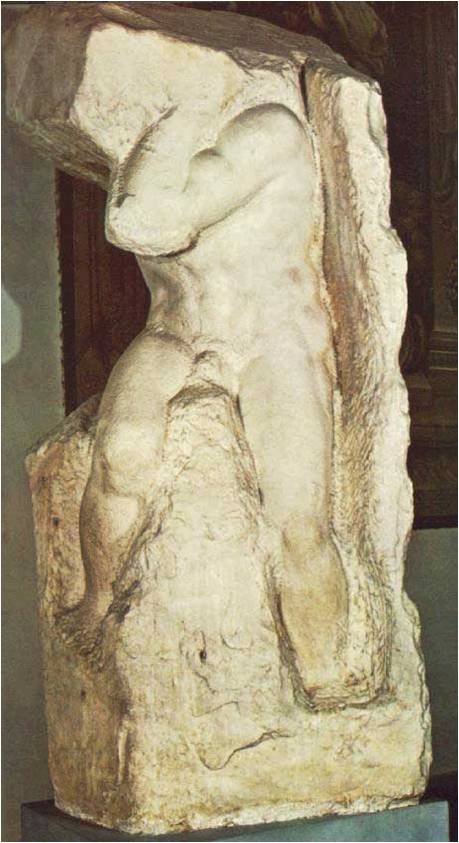
Able Muse—A Review of Metrical Poetry. Web. 13 Dec 2011.
http://www.ablemuse.com/premiere/bhouston_unfinished.htm
|
Donatello, David, 1432

Temple College—
The Florentine Renaissance: 1400-1492.
Web. 13 Dec 2011.
http://tc.templejc.edu/dept/Art/ASmith/arts%201304/Joe1/ZoomSlide0017A.html
|
Michelangelo, David, 1501-4
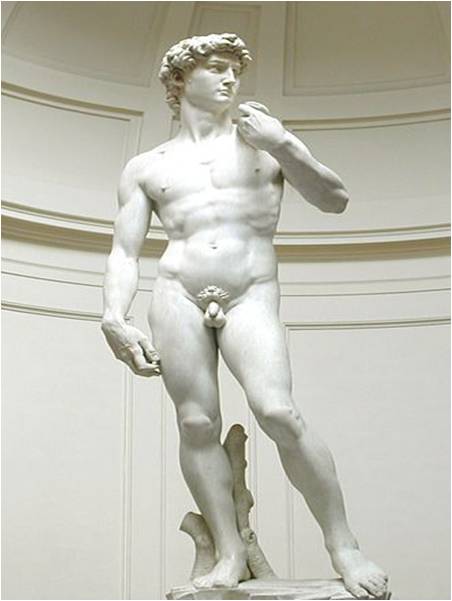
Wikipedia. Web. 13 Dec 2011.
http://es.wikipedia.org/wiki/Archivo:Michelangelos_David.jpg
|
a. 1501 commissioned by the new republican government in Florence
b. A symbol of resistance and independence
c. The first full statement of Michelangelo’s heroic style
d. Embodies the Renaissance ideals of terribilità (awesomeness) and virtù
(Piper 132; Fiero 422-23)
|
|
Pieta
|
|
Roettgen Pieta. Early 14th century
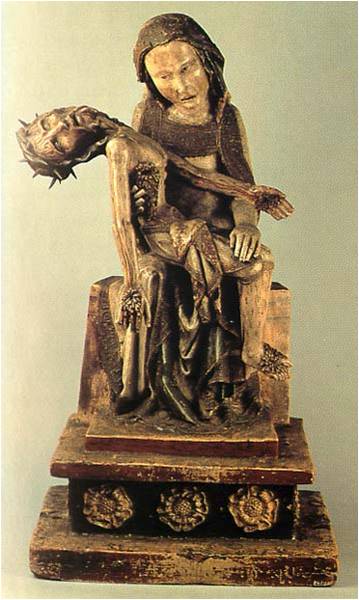
The Slide Projector. Web. 13 Dec 2011.
http://www.theslideprojector.com/art6/
art6lecturepresentations/art6lecture3.html
|
Michelangelo, Pietà, 1497-1500
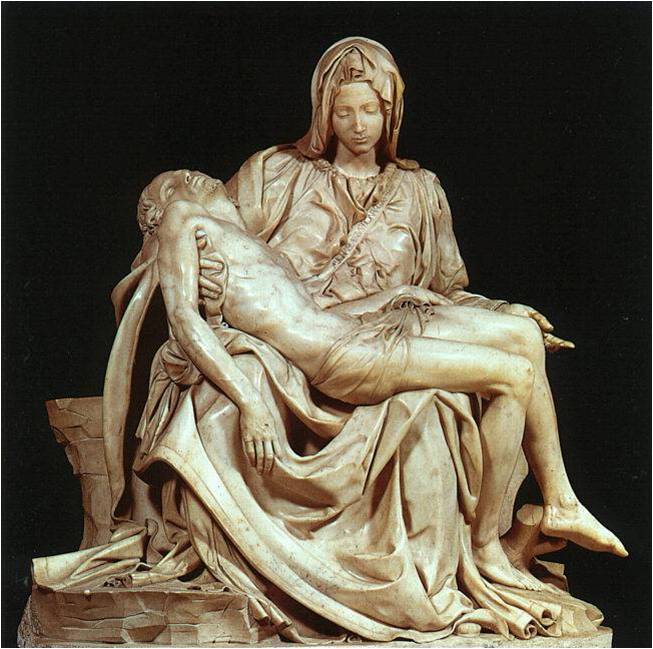
Garden of Praise. Web. 13 Dec 2011.
http://gardenofpraise.com/art50.htm
a. Lifeless Jesus held by young Virgin
b. Protective pyramidal shape
c. Monumental statement on the meaning of Christian Sacrifice
(Fiero 422)
|

|
|
Works Cited
|
|
Black, C. F., Mark Greengrass, David Howarth, Jeremy Lawrence, Richard Mackenney, Martin Rady,
and Evelyn Welch. Cultural Atlas of the Renaissance. New York: Prentice Hall, 1993.
Fiero, Gloria. The Humanistic Tradition. Vol. 1. 6th ed. New York: McGraw-Hill, 2011.
Perry, Marvin, Joseph R. Peden, and Theodore H. Von Laue. Sources of the Western Tradition. 5th
ed. Vol.1. Boston: Houghton Mifflin, 2003.
Piper, David. The Illustrated History of Art. London: Chancellor, 1981.
|